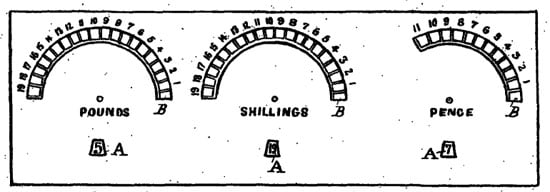BriCal, meaning British Calculator, is a brass calculator which was designed by Herbert and Mabel Dickinson and patented in 1905. It consisted of three or more concentric brass discs which were drawn clockwise with a stylus to add pounds, shillings, and pence (the British currency at the time). Sums could be calculated in pre-decimal currency up to £500. Eventually, some BriCals were made to work in different currencies, while others were designed which were able to add up sums of more than £500. However, although the BriCal was popular during its time, it was eventually discontinued sometime during the 20th century.
Read on to explore the full history of the BriCal, how it was designed, and how it worked.
BriCal History

BriCal (after British Calculator) is a circular brass calculator, patented in 1905 by the engineer Herbert Dickinson and his wife, Mabel Dickinson. The adding machine was manufactured by the company British Calculators Ltd, London, from 1905 till the 1920s in different variants. The most common is a disk, with a diameter of 135 mm and thickness of 10 mm, weighing 450 g, put in a special case with velvet.
The exact time the company ended is unknown. It appears most of the BriCal calculating machines were manufactured in the first 10 to 20 years. Other sources cite manufacturing lasting until the 1950s.
BriCal: How It Worked

This particular British calculator machine has three or more concentric brass discs which are drawn clockwise with the stylus to add pounds, shillings, and pence. Using the pin or stylus, one rotates the chain, until the wanted sums show in the window of the adding machine. Sums can be calculated in pre-decimal currency up to £500.
In order to clear the calculator, it surprising takes a few steps. It does seem odd to have to take so much time for a tool that is saving time calculating. One has to notice where a red dot is on some of the teeth and then pull those teeth to zero using the stylus. Next, you have to do the same for the other two rings that are left. Finally, the counter wheel must be reset to zero by using the tiny knob. If all these steps are preformed, a user can move on to the next computation.
These are just the basic instructions for the original BriCal. The machine was manufactured in a surprising number of variants for its apparently short production time.
Some BriCal machines were manufactured to work with different currencies. Others could calculate sums over £500. Still others were designed in different sizes and colors.
BriCal: Historical Significance
According to the BriCal money calculating machine instruction booklet, this machine is capable of calculating British currency six times as fast as mental addition. While the machine appears to have been popular during its time, it was discontinued sometime in the 20th century. Some report it was only in production for approximately 10 to 20 years, with manufacturing ceasing some time before 1925. Others claim it was manufactured until 1950.